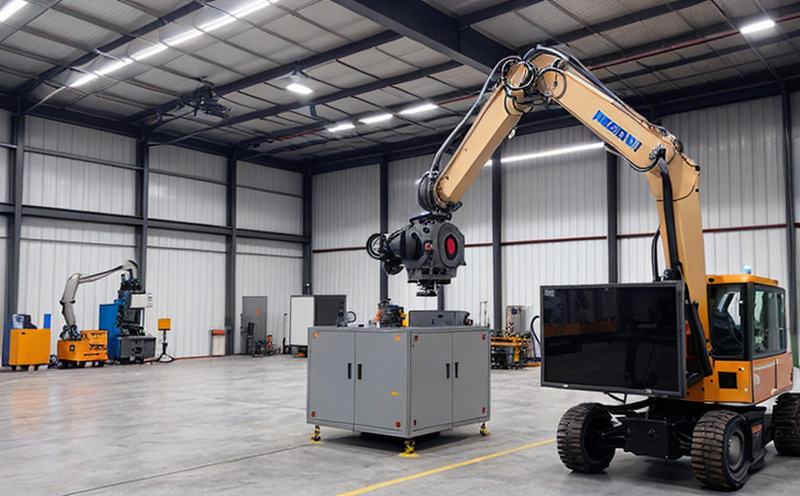ASTM F2987 Vibration Resistance in Industrial Robotic Equipment
The ASTM F2987 standard is a critical tool for manufacturers and quality assurance teams working with industrial robotic equipment. This test evaluates the vibration resistance of robotic arms, sensors, and other components under conditions that mimic real-world factory environments. The purpose of this test is to ensure that robotic systems can perform their functions reliably in environments characterized by vibrations.
Manufacturers use ASTM F2987 during product development to identify potential issues with design or material choices before production begins. Quality managers rely on the results from this test to confirm compliance with industry standards and to demonstrate a commitment to product quality. Compliance officers ensure that all products meet regulatory requirements, while R&D engineers can fine-tune designs based on the feedback provided by ASTM F2987.
The standard is particularly important for industries where precision and reliability are paramount, such as automotive manufacturing, electronics assembly, pharmaceutical production, and aerospace engineering. In these sectors, even minor vibrations can lead to significant errors or failures in robotic operations, impacting not only productivity but also safety.
ASTM F2987 specifies a series of test procedures that simulate the vibratory environments encountered by industrial robots during operation. These tests are designed to replicate the conditions under which the robotic equipment will actually be used. This ensures that the results from ASTM F2987 provide meaningful insights into how well the equipment will perform in real-world settings.
The testing process involves subjecting the robotic equipment to controlled vibrations using specialized vibration test machines. The equipment is placed on a platform that can generate and apply precise levels of vibratory force, frequency, and duration. This setup allows for the systematic evaluation of how different components of the robot respond to various degrees of vibration.
Once testing is complete, detailed reports are generated summarizing the performance of the robotic equipment under test conditions. These reports include data on the extent of any damage or degradation observed in the equipment as a result of exposure to vibrations. The information provided by these reports helps manufacturers make informed decisions about design improvements and material selection.
The ASTM F2987 standard is widely recognized within the robotics industry, providing a consistent benchmark for evaluating vibration resistance across different models and brands. This uniformity ensures that all participants in the market are held to the same standards, fostering trust among buyers and sellers alike.
- Why Choose This Test: ASTM F2987 provides manufacturers with essential data on how their robotic equipment will perform under real-world conditions.
- International Acceptance and Recognition: The standard is widely adopted globally, ensuring that results are universally accepted in the industry.
In summary, ASTM F2987 plays a vital role in maintaining high standards of quality and reliability for industrial robotic equipment. By adhering to this test procedure during development stages, manufacturers can identify potential weaknesses early on, leading to more robust products that meet both customer expectations and regulatory requirements.
Applied Standards
The ASTM F2987 standard is part of a broader framework of testing protocols designed specifically for industrial robotic equipment. It draws heavily from other standards such as ISO 13046-1, which provides general guidelines for evaluating the dynamic performance of industrial robots, and ASME B15.16M, which covers safety requirements for industrial robots.
ASTM F2987 focuses on the vibration resistance aspect, ensuring that robotic systems can withstand the rigors of factory environments without losing accuracy or functionality. By combining these standards, engineers have access to a comprehensive set of tools and best practices that help them design and test robotic equipment effectively.
The standard is continuously updated to reflect advancements in technology and new challenges faced by the industry. Regular updates ensure that ASTM F2987 remains relevant and useful for practitioners across all segments of industrial robotics.
Why Choose This Test
- Identify potential issues early in development, leading to more robust products.
- Ensure compliance with recognized industry standards, enhancing credibility and trustworthiness.
- Provide detailed insights into equipment performance under real-world conditions, improving design accuracy.
- Demonstrate a commitment to product quality and reliability, appealing to discerning customers.
Selecting ASTM F2987 as part of your testing protocol can significantly enhance the durability and functionality of industrial robotic systems. It offers manufacturers a valuable tool for ensuring that their products meet stringent performance criteria.
International Acceptance and Recognition
The ASTM F2987 standard enjoys widespread acceptance within the international robotics community. Its recognition extends beyond national boundaries, making it an essential tool for companies operating globally or seeking to penetrate foreign markets.
The standard is widely used in countries like the United States, Europe, Japan, and South Korea, where industrial robotic equipment plays a crucial role in manufacturing processes. By adhering to ASTM F2987, manufacturers can ensure that their products meet the same high standards expected by customers worldwide.
Compliance with this standard also facilitates smoother international trade by ensuring that products are compatible with regulatory requirements across different regions. This consistency reduces the risk of non-compliance issues and helps build stronger relationships between suppliers and buyers.
The global reach of ASTM F2987 underscores its importance as a benchmark for quality in industrial robotic equipment testing. Manufacturers who choose to comply with this standard position themselves favorably in competitive markets, reinforcing their reputation for delivering reliable and high-quality products.





